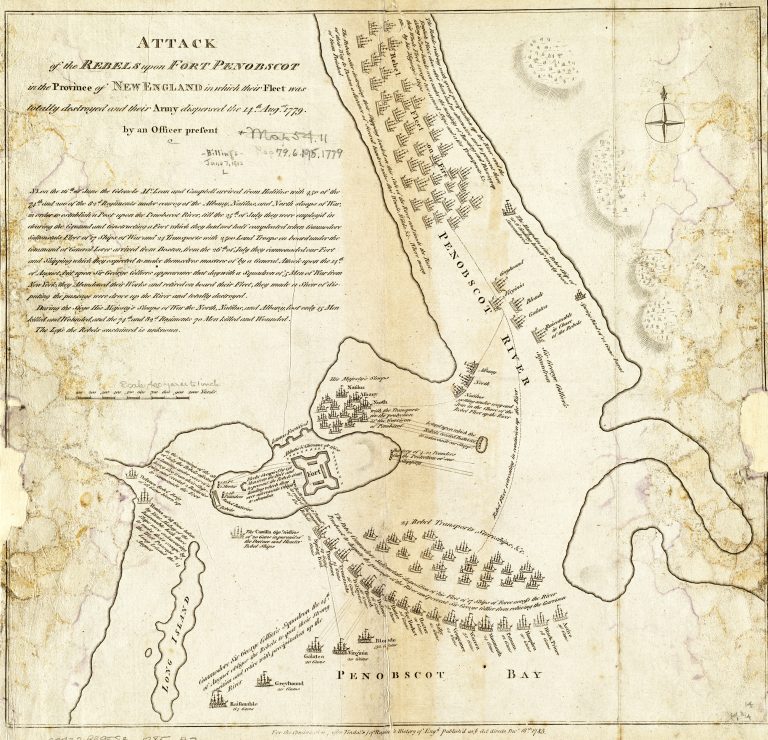I am currently reading
“Revolution Downeast, the War for American Independence in Maine” by James
Leamon. I spend a lot of time in Maine.
A while back I read “Valour Fore and Aft” by Hope S. Rider, a book about
the Continental sloop Providence, formerly the sloop Katy of the
Rhode Island Navy. It was the first account I had read of the fiasco on the
Penobscot in 1779. That ship had a lucky career, taking prizes and raiding Caribbean
islands until it took part in the doomed Penobscot expedition.
Maine, then a sub-colony of
Massachusetts, had avoided much more than naval raids from the British until
mid-June, 1779. Five Royal Navy warships escorted transports carrying 700
regulars, who landed on the east side of Penobscot Bay and began building Fort
George. Massachusetts called for a fleet and an army to seize the fort. To increase participation it agreed to insure any privateer ships taking part. Continental Navy ships, led by the 32-gun
frigate Warren, and two smaller ships including the Providence, were
the core of the flotilla. Some small ships from the Massachusetts Navy
and many privateers, anticipating a windfall, joined in. The flotilla had 19
warships in all, plus 24 transports. 1,500 militia were called for, though less than 1,000 showed
up. Those that did were the ones the local militia commanders had the least use
for; very young, very old or otherwise less than stellar recruits.
The flotilla was commanded by
Commodore Dudley Saltonstall of the Warren. He was a brave ship captain
but would prove sadly lacking in higher command. The militia force was led by militia
Brigadier General Solomon Lovell, with limited experience and none in
independent command. He was a genial sort; the Commodore was not. It was an
unfortunate pairing.
The American flotilla dropped
anchor within sight of the fort on July 25. The fort was still under
construction. A mere three British sloops of war anchored to protect the fort
in a strong position. Attacking ships would have to navigate a narrow channel
to close. Many naval officers in the flotilla cried for an immediate attack.
The Commodore demurred, passing the buck to the General, who also balked. On
July 28, 400 militia and Marines landed within striking distance of the fort,
scaled a cliff and drove the redcoat detachment back in confusion. The British
were demoralized; the fort incomplete, the commanding officer considering
surrender. But no further attack came. The attacking force was disorganized by
their success and they were not reinforced. The Commodore and the General each
tried to get the other to make a move first. British morale recovered as the
fort walls grew higher each day. American morale sagged as the two commanders
argued, doing little else for weeks. The militia were loath to work and even less inclined to assault the growing enemy works. The two leaders finally decided on a
concerted attack on land and afloat, set for August 13.
That day a Royal Navy squadron with a 64-gun ship of the line, 4 frigates, a sloop and a brig arrived, joining the 3 sloops guarding the fort. The privateers fled in terror, joined soon by the state ships. Then the outgunned Continental ships joined the rout up the Penobscot, firing nary a shot. Ship after ship was run aground and burned as the crews and militia fled. The chase continued until nightfall; most ships burned, the rest taken. Crews and militia alike fled through the woods, taking most of a week to escape. Losses were somewhere between 100-500. I suspect the lower number, but the British losses were tiny. Much of this I learned from “Valour Fore and Aft”. That book is a good read, and for ship modelers, a good source for building a replica of the Providence. Ken loaned it to me after using it to build his model.

Ken's 1/48 model of the Providence.
Found another map, not nearly as pretty but makes much mores sense when reading about the action.
“Revolution Downeast”, my current reading, throws further light on this. An inquiry into the causes of this debacle put all blame on the Commodore since he was a Connecticut man and a Continental officer, with no backing in Massachusetts. Massachusetts, nearly bankrupted by the loss of the expedition, was trying to get the Continental Congress to pay the promised insurance bills for all those scuttled privateers. The Commodore was certainly culpable, as was the General. But the General was a Massachusetts politician. His indecision during the siege and desertion during the rout was ignored, as was the generally poor performance by the militia.I’ve not yet finished the current
book. It covers the war in Maine in great detail, possibly too much for some. A
close look reveals a good number of people, loyalist and patriots alike, whose political
stands and chance for profit were intertwined, rather than the altruism usually
cited. Many people preferred staying out of harm’s way to bravery. The book
also details the hard effect of the British naval blockade on the economy, the
worst burden falling on the poorest, who were reduced to scrabbling for basic
needs.
The disaster on the Penobscot is
an example of how incompetent leadership of poorly trained forces can waste a huge
numerical advantage.




